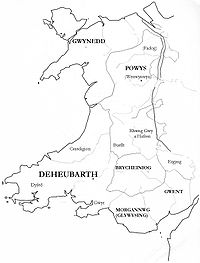Deheubarth: Difference between revisions
Created page with 'right|thumb|150px|Arms attributed to Deheubarth right|thumb|200px|Mediaeval Welsh kingdoms [[File:Deheubarth.P…' |
|||
| Line 55: | Line 55: | ||
{{reflist}} | {{reflist}} | ||
*''The Welsh Academy Encyclopaedia of Wales''. Cardiff: University of Wales Press, 2008 ISBN 978-0-7083-1953-6 | *''The Welsh Academy Encyclopaedia of Wales''. Cardiff: University of Wales Press, 2008 ISBN 978-0-7083-1953-6 | ||
[[Category:British kingdoms]] | |||
Latest revision as of 13:31, 8 January 2016



Deheubarth was a petty Welsh kingdom or principality in the Middle Ages. Its name literally means "south part" and it encompassed in its day the southwest of today's Wales.
History
Deheubarth was founded circa 920 by Hywel Dda ("Hywel the Good") out of the territories of Seisyllwg and Dyfed, both of which had come into his possession. Later on, the Kingdom of Brycheiniog would also be added to its territory. The chief seat of the rulers of Deheubarth and its traditional capital was at Dinefwr, although Carmarthen and Cardigan also served as the kingdom's capital for certain periods.
Deheubarth, like several other Welsh states, continued to exist until the Norman Conquest of Wales, but constant power struggles meant that only for part of the time was it a separate entity with an independent ruler. It was annexed by Llywelyn ap Seisyll of Gwynedd in 1018, then by Rhydderch ab Iestyn of Morgannwg in 1023. Llywelyn ap Sisyll's son, Gruffydd ap Llywelyn again annexed Deheubarth and became ruler of most of Wales, but after his death the old Dinefwr dynasty regained power.
In the arena of the church, Sulien was the leader of the monastic community at Llanbadarn Fawr (in Cardiganshire). Born around 1030, he became Bishop of St David's in 1073. Both of his sons followed him into the service of the church. His sons produced a number of manuscripts and original Latin and vernacular poems. They were very active in the ecclesiastical and political life of Deheubarth. One son, Rhygyfarch (known as Ricemarch in Latin) of Llanbadarn Fawr wrote the Life of Saint David, and another, Ieuan, was a skillful scribe and illuminator. He copied some the works of Augustine of Hippo and may have written the Life of St Padarn.
Rhys ap Tewdwr ruled from 1078 to 1093 and was able to fight off several attempts to dethrone him, considerably increasing the power of the kingdom. However the Normans were now encroaching on the eastern borders of Deheubarth, and in 1093 Rhys was killed in unknown circumstances while resisting their expansion in Brycheiniog. This led to the Norman conquest of most of his kingdom, with his son Gruffydd ap Rhys temporarily reduced to being a fugitive. Gruffydd did eventually become prince of a small part of his father's kingdom, but most was carved up into various Norman lordships.
There was a general revolt against the Normans in 1136, following the death of Henry II, and Gruffydd formed an alliance with Gwynedd. Together with Owain Gwynedd and Cadwaladr ap Gruffydd of Gwynedd he won a victory against the Normans at the Battle of Crug Mawr near Cardigan. This took the land of Ceredigion from Norman rule but instead of returning it to Deheubarth, Gwynedd annexed it. Gruffydd was killed in unknown circumstances the following year.
The rule of Deheubarth now fell to Gruffydd's sons, of whom four, Anarawd, Cadell, Maredudd and Rhys ap Gruffydd ruled in turn. The death of a ruler frequently led to disunity and struggles for supremacy, but the four brothers worked together to win back their grandfather's kingdom from the Normans and to expel Gwynedd from Ceredigion. Of the first three, only Cadell reigned for more than a few years, but the youngest of the four, Rhys ap Gruffydd (The Lord Rhys), ruled from 1155 to 1197, and after Owain Gwynedd's death in 1170 made Deheubarth the most powerful of the Welsh kingdoms.
Upon Rhys ap Gruffydd's death in 1197, the kingdom was split between several of his sons, and Deheubarth never again rivalled the power of Gwynedd. The early 13th century princes of Deheubarth usually appear as clients of Llywelyn the Great of Gwynedd. Following the defeat of the princes of Gwynedd and the division of their realm authorised by the Statute of Rhuddlan, Deheubarth was divided into the counties of Cardigan, Carmarthen and Pembroke.
Kings and Princes of Deheubarth
- Hywel Dda ap Cadell 909-950 (established the Dinefwr branch of descendants of Rhodri the Great)
- Rhodri ap Hywel 950-953
- Edwin ap Hywel 950-954
- Owain ap Hywel 950-987
- Maredudd ab Owain 987-999
- Cynan ap Hywel (King of Gwynedd) 999-1005
- Edwin ab Einion 1005-1018
- Cadell ab Einion 1005-1018
- Llywelyn ap Seisyll (King of Gwynedd) 1018-1023
- Rhydderch ab Iestyn (Prince of Morgannwg) 1023-1033
- Hywel ab Edwin 1033-1044
- Gruffydd ap Llywelyn 1044-1045
- Gruffydd ab Rhydderch 1045-1055
- Gruffydd ap Llywelyn 1055-1063
- Maredudd ab Owain ab Edwin 1063-1072
- Rhys ab Owain 1072-1078
- Rhys ap Tewdwr 1078-1093
- Gruffydd ap Rhys 1135-1137 (part only, the remainder held by Normans)
- Anarawd ap Gruffydd 1137-1143
- Cadell ap Gruffydd 1143-1153
- Maredudd ap Gruffydd 1153-1155
- Rhys ap Gruffydd (The Lord Rhys) 1155-1197
- Gruffydd ap Rhys II 1197-1201
- Maelgwn ap Rhys (1199-1230) (part)
- Rhys Gryg (1216-1234)
- Rhys Mechyll (1234-1244) (Cantref Mawr only)
- Maredudd ap Rhys Gryg (1244-1271) (Cantref Mawr only)
- Rhys ap Maredudd (1271-1283) (Cantref Mawr only, then from 1287 in rebellion, executed 1292)
Outside links
References
- The Welsh Academy Encyclopaedia of Wales. Cardiff: University of Wales Press, 2008 ISBN 978-0-7083-1953-6